Introduction (Click here or scroll down for Images)
History
Despite the on-again/off-again nature of the Executive and Assembly and their suspension in 2002 (which would last until 2007), peace was largely maintained and decommissioning gradually took place: the IRA would complete the decommissioning of its weapons by September 2005, the UVF by June 2009, and the UDA by January 2010.
Muraling
In CNR muraling, energy that had been used to support the military campaign was channelled into the political campaign, pressing for the realisation of various policies described in the Good Friday Agreement. Chief among these was the reformation of the RUC and policing in accordance with the Patten Report, followed closely by demands for investigations into collusion between the security forces and loyalist paramilitaries.
There were, however, anti-Agreement groups that continued to espouse physical-force resistance; the quality of their visual displays, however, matched the paucity of their support.
In PUL muraling, much uncertainty about the post-Agreement world continued and found expression in hooded gunmen.
The differing reactions to the Agreement and the process of decommissioning can be exemplified by the two most concerted muraling initiatives of the pre-re-imaging period, namely the (UDA West Belfast Brigade) C Company murals under Johnny Adair in the lower Shankill estate and the Ballymurphy Mural Project.
Images
CNR Muraling
For republicans during and after the peace process, the status of the police force – the Royal Ulster Constabulary (RUC) – was top of the list of reforms. Those in favour of the peace process and those against it alike called for the disbandment of the existing force. The Police Service of Northern Ireland came into being on November 4th, 2001. Sınn Féın refused to support it until the Patten Report – the advisory document making 175 recommendations concerning policing – was enacted in full, reflecting the ambivalence of republicans generally. Militant republicans refused to endorse the force at all. In the murals and graffiti on the issue, it is sometimes hard to tell which pieces come from which faction. That “nothing has changed”, for example, might be a demand for change, on the one hand, or constitute an outright rejection, on the other.

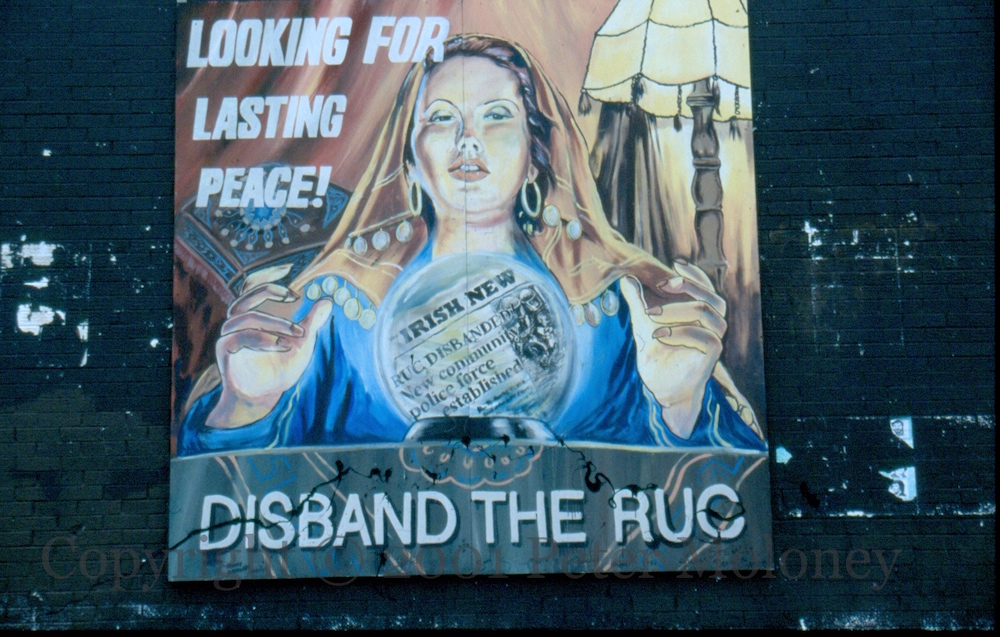
The emblem of the new PSNI, outside the Strand Road station, London-/Derry.
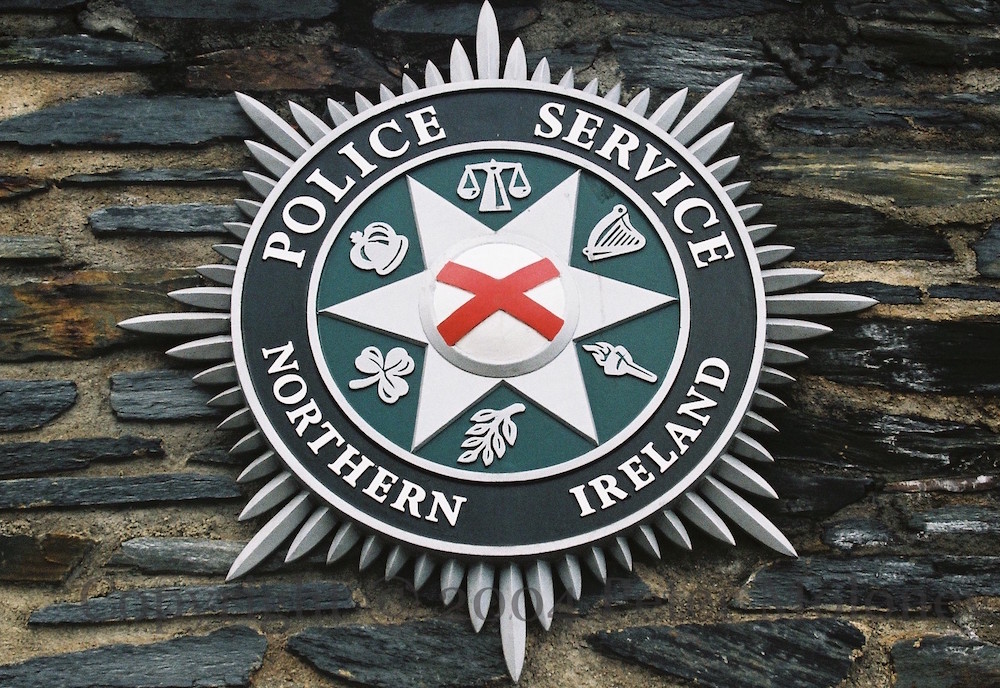
“PNSI – Patten Still Not Implemented” on the International Wall, Divis Street, Belfast.

“Reject The ‘New’ RUC”. Falls Road, Belfast.

The Northern Ireland Policing Board was founded in 2001 to oversee the PSNI. It was initially constituted with three SDLP members, depicted here (Bridge Street, Strabane) as puppets of the Special Branch. Sınn Féın would not take its seats on the board until 2007.

“Nothing Has Changed!” More puppetry, this time the RUC/PSNI control David Trimble, George Mitchell, and Ian Paisley. Fahan Street, Bogside, Derry.

The most blunt PSNI-related graffiti, by the unrestrained youth in the Bogside, Derry: “Kill all PSNI officers now RIRA.”

A closely-related issue was collusion between the security forces (the RUC and British Army) and loyalist paramilitaries during the Troubles.
“PSNI Murderers” on New Lodge Road, Belfast.
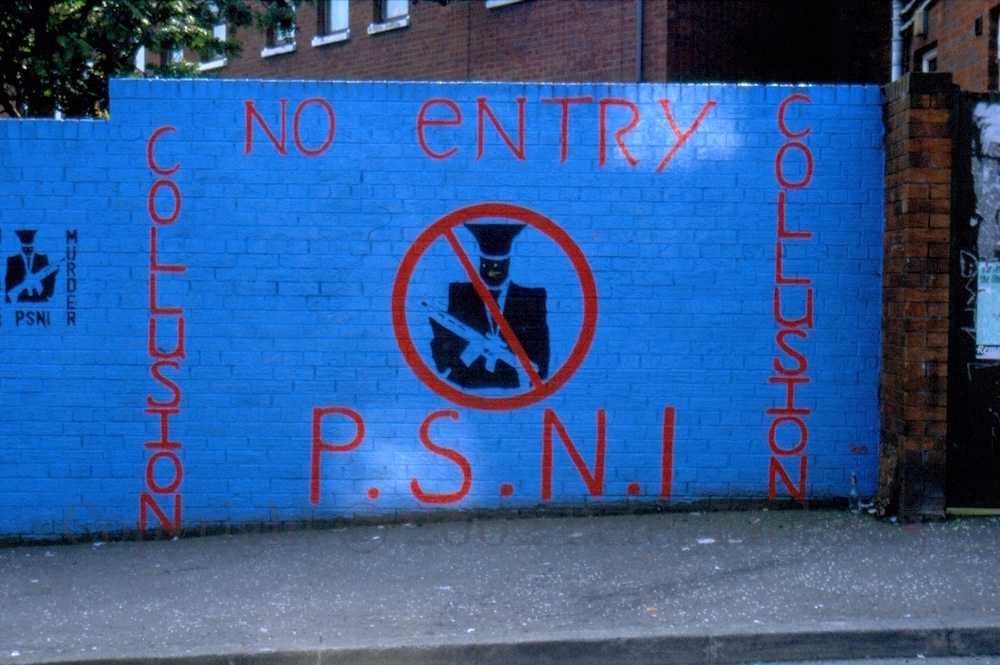
Beechmount Avenue, Belfast.
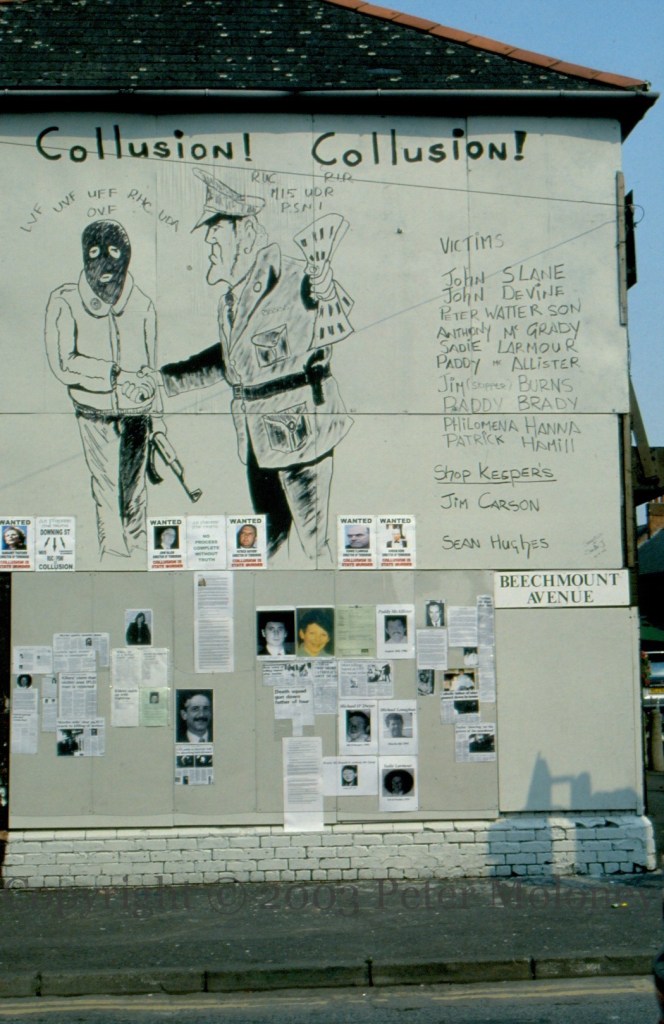
Whiterock Road, west Belfast, with a quote from Gusty Spence.

Ardoyne Avenue, Belfast, bringing back an image from 1989: Springhill | Beechmount.

A march to highlight collusion was held in July 2003 – see four rallying calls in Collusion Is State Murder, and another in M01997 – and another in August – see M01998 | M01950. See also 2003 M01974 & M01976 & M01979 | M02000.
The Irish language began to get some attention; an Irish Language Act would later become a central Sınn Féın campaign. This mural in west Belfast is for Irish-language advocacy group Pobal.

In the summers of 2001 and 2002, there was “persistent and recurrent violence in the interface areas” between Catholics in the small enclave of Short Strand and Protestants from east Belfast (ICR | BBC-NI | Guardian). Republicans dubbed 2002 the “siege of Short Strand”. The height of the “peace” walls around Bryson Street, Madrid Street, and Cluan Place was increased (Guardian).
In the mural below, the situation is compared unfavourably to the biblical story of “David & Goliath”: “Just because you’ve read it somewhere, you don’t have to believe we’re this crazy!

Support in west Belfast for the Catholics in east Belfast.
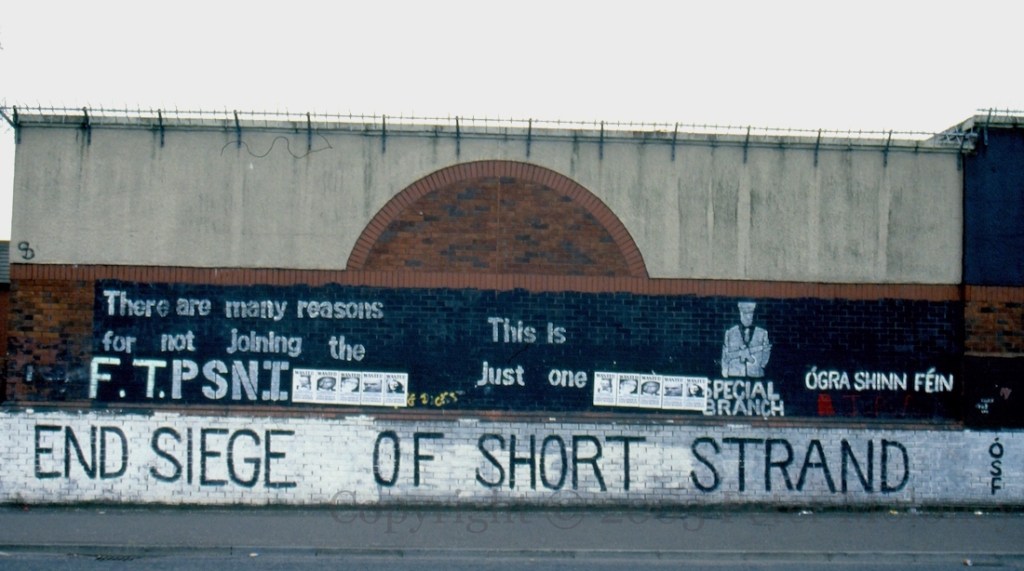
See also the cases of “political prisoners” the Castlerea 5 (2001 M01498 | 2003 M01951) and Seamus Doherty (2004 M02143 | 2004 M02146 | 2004 M02159 | 2004 M02175).
A final piece of republican muraling worth noting is this simple anti-racism stencil, the first anti-racism piece in the collection. It is notable because the message is directed inwards, at the republican community, in connection with the treatment of immigrants. Eight eastern European countries were admitted to the EU in 2004 and approximately 122,000 migrants would settle in Northern Ireland between 2000 and 2010 (Russell 2012).

PUL Muraling
Skepticism about the functioning of the Agreement was detailed in this lower Shankill mural: “This is the Sinn Fein commitment to the peace process: guns from Florida, training FARC rebels, Castlereagh break-in [the chef is Larry Zaitschek but see Independent and Guardian], Stormont spy-ring [Stormontgate].”
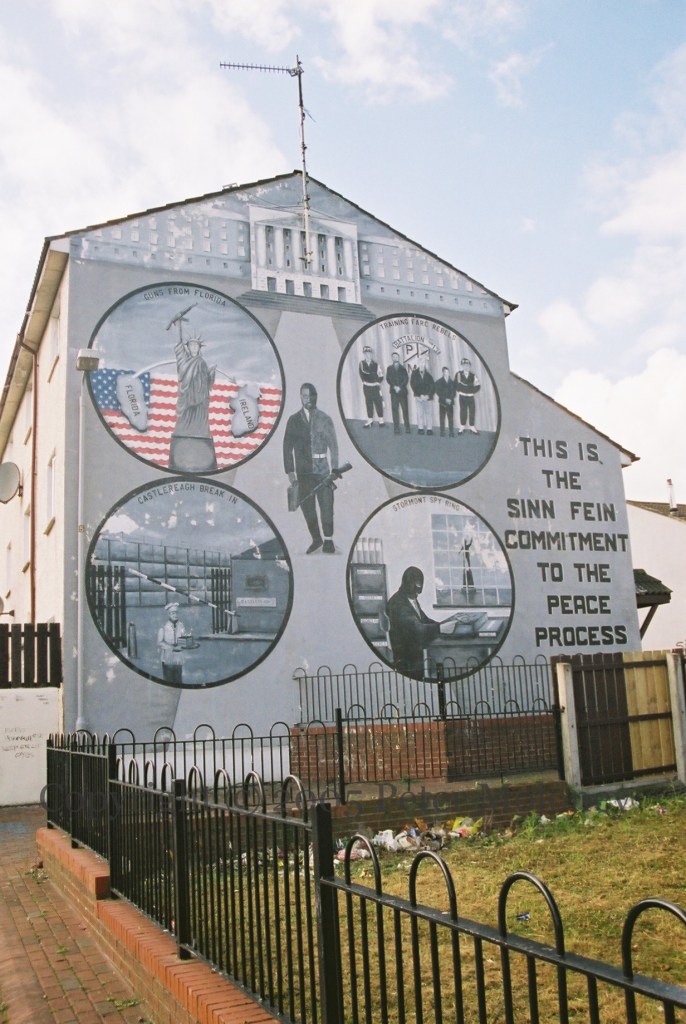
This Canmore Street (Belfast) mural includes the riots of 1969 as a third moment in the history of loyalism between 1912, 1916 and the present day, where the gunman stands at the junction between war and peace.

The UVF continued to use imagery of the Ulster Volunteers and 36th Division a theme first mentioned in Visual History 08, but it increasingly became “confused” with modern-day UVF volunteers. (Glenwood St, Belfast)
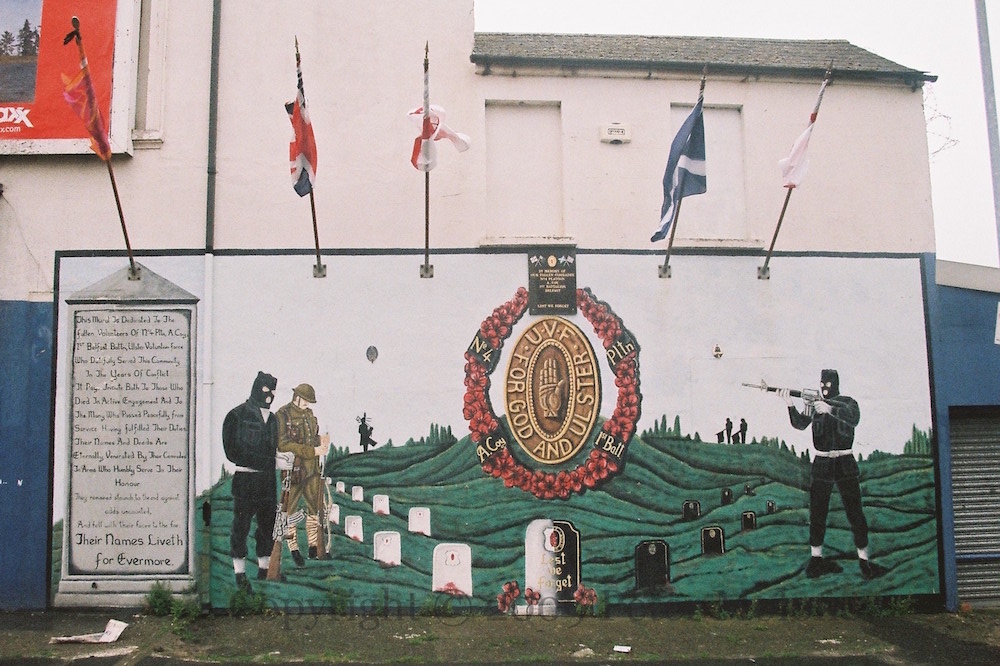
Denver Smith mural in (PUL) Parkhall, Antrim, again combining the 36th Division with the UVF.
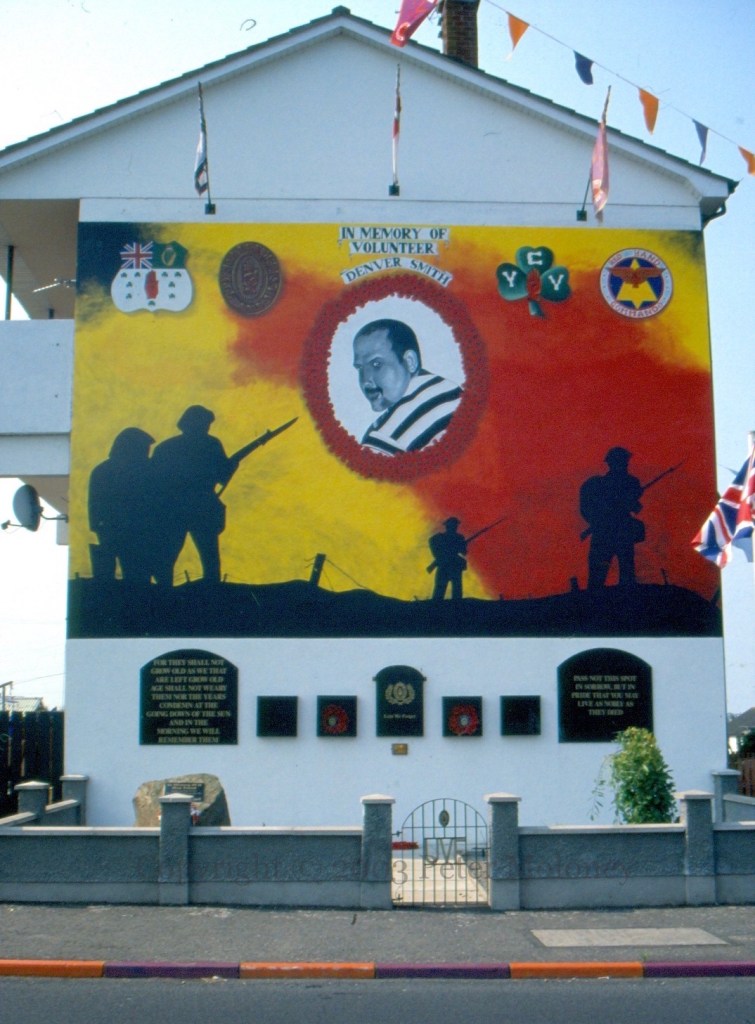
A number of murals were painted to celebrate Queen Elizabeth II’s 50th anniversary of accession (1952) and coronation (1953). This portrait is in Bond’s Place in the Waterside, Londonderry, where there was also added a mural to Cecil McKnight (M02024).

See also: 1952-2002 in Rathcoole (2015 dating to 2002 X02489) | 1952-2002 in Argyle St/Shankill (2005 dating to 2002 M02455) | 1952-2002 Cashel Dr, Monkstown (2006 dating to 2002 M03065 and M03066).
Also: Diana in lower Shankill (2000) | Queen Mother in Conway St/Shankill (2004 dating to 2002 X00072).
Finally, a traditional image – the Relief Of Derry – in the (PUL) Fountain, Londonderry.

The Adair-Era Murals In The Lower Shankill
In 2000 an astonishing number of murals – at least 18 large pieces and several smaller ones – were painted in and around Adair’s lower Shankill stronghold, and a few more were added in 2001 and 2002.
(The Lower Shankill murals have their own Visual History page.)
The murals spanned the range of themes that we have seen on previous pages.
As expected the majority were UDA/UFF emblems and hooded gunmen. The most disconcerting of the hooded gunmen was actually in a historically-themed mural, linking the current UDA to the UDU, but with a centrally-placed hooded gunman who always seemed to be aiming directly at the viewer …
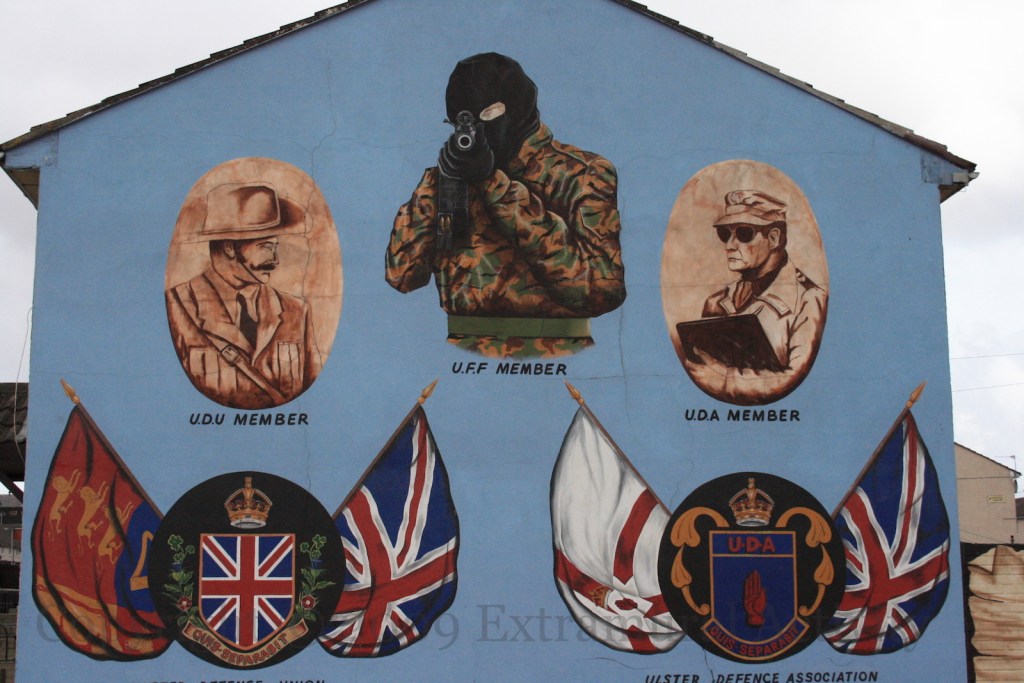
… and there was a version of Eddie The Trooper with the names of the Shankill bombers (Copeland, Kelly, Larkin) on the crosses

… and a more playful version on the same theme, with Spike (the dog from Tom & Jerry) brandishing an assault rifle and chasing Gerry Adams up the Shankill Road, past the murals at and behind the KFC.

There were also deceased volunteers — Billy Wright of the LVF, with which Adair was forging connections, Stevie McKeag, Bucky McCullough, Jackie Coulter — and a few were on traditional/-ish cultural themes such as King Billy and the Siege Of Derry.
Novel were the mural to Princess Diana — only kings and queens had been painted previously …
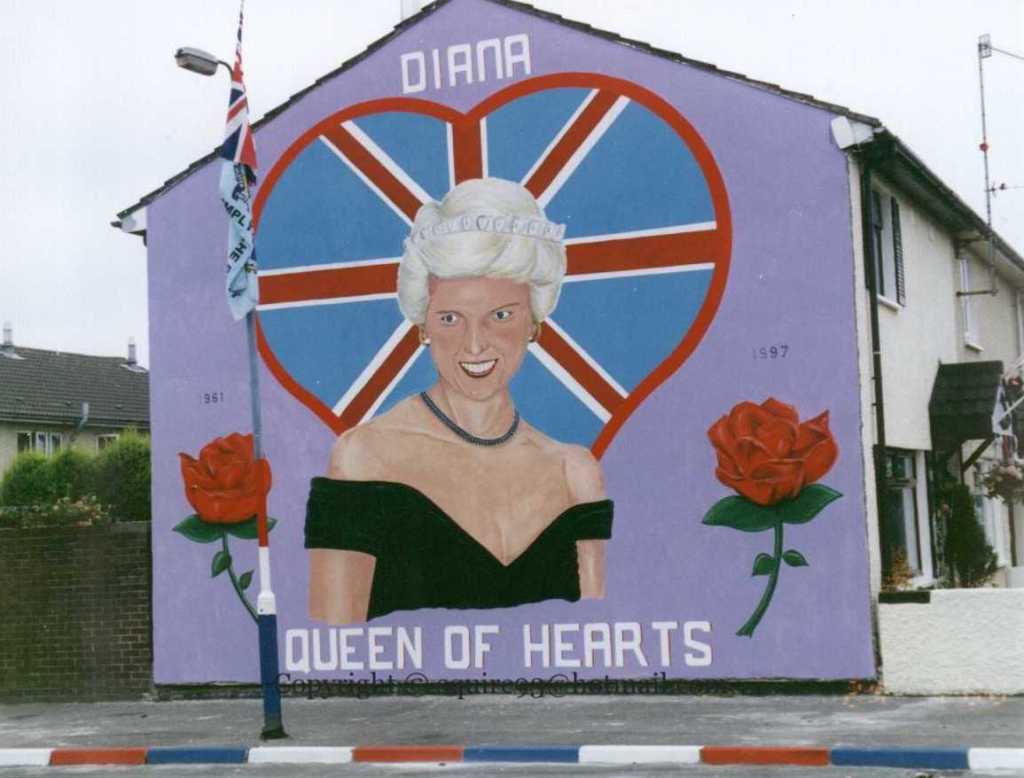
… and a historical piece commemorating the persecution of Protestants in “1600” (probably the Irish Rebellion of 1641)

Adair’s conflicts with the UVF and other brigades of the UDA led eventually to his allies being driven out of the lower Shankill in September 2002 (Adair was in prison at the time). With Adair removed, seven (according the the Belfast Telegraph) or more of the murals were painted over.
(Re-imaging in the sense of state-sponsored murals on less sectarian themes would come to the lower Shankill in 2009 as part of the Re-Imaging Communities project – see Visual History 10.)
The Ballymurphy Mural Project
The major initiative on the CNR side was the Ballymurphy Mural Project, which added seven murals to previously unpainted walls in Ballymurphy, west Belfast, in 2002. The purpose of the project was to honour members of the community who had fought and been active in the struggle that had been transformed by with the ceasefire, the Agreement, and the decommissioning process. The murals feature armed volunteers (from the IRA, Cumann Na mBan, and Fıanna) as well as Sınn Féın activists and local people who supported the struggle. In many respects they are similar to “active” IRA murals, particularly in the array of armaments on display, but the volunteers are always named and always bare-faced rather than hooded.
(The Ballymurphy Mural Project has its own Visual History page.)
Cumann Na mBan mural to Maura Meehan, Anne Marie Pettigrew, Dorothy Maguire, Eileen Mackin, Catherine (Cathy) McGartland, Anne Parker.

John Stone, Jason McWilliams, Kevin McCracken, John Dougal. With smaller portraits of Annie McWilliams, Mary Austin, Kathleen Clarke.

Early Re-Imaging
Visual History 10 focuses on re-imaging (getting rid of loyalist gunmen). Here is a minor and early example of re-imaging from Sandy Row in 2002. A mural for the 300th anniversary of the Boyne (below, also seen in Visual History 06) which showed a Williamite and a paramilitary (flanking King William on his horse) was repainted and the paramilitary volunteer replaced by another Williamite. On the other hand, a UYM emblem (M02401) was added above the mural!


On to Visual History 10 – Re-Imaging (2003-2009)
References in parentheses to mural collections:
D = squire93@hotmail.com collection
M = Peter Moloney Collection – Murals
X = Seosamh Mac Coılle Collection
Back to the index of Visual History pages.
Copyright © 2018-2025 Extramural Activity. Images are copyright of their respective photographers.